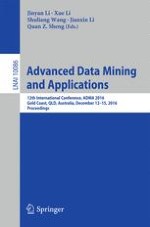2016 | Buch
Advanced Data Mining and Applications
12th International Conference, ADMA 2016, Gold Coast, QLD, Australia, December 12-15, 2016, Proceedings
herausgegeben von: Jinyan Li, Xue Li, Shuliang Wang, Jianxin Li, Quan Z. Sheng
Verlag: Springer International Publishing
Buchreihe : Lecture Notes in Computer Science
